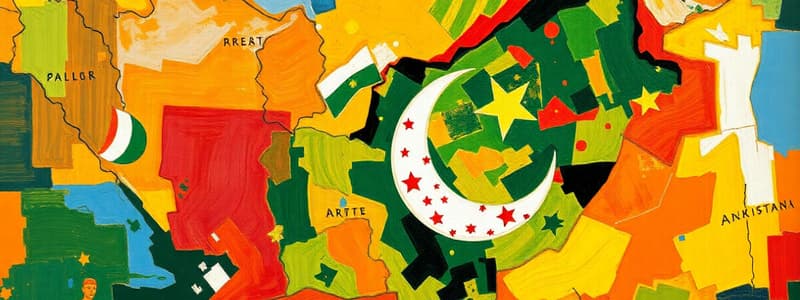Podcast
Questions and Answers
What was a significant outcome of the 1940 Lahore Resolution?
What was a significant outcome of the 1940 Lahore Resolution?
- Establishment of Pakistan in 1947 (correct)
- Drafting the first constitution of Pakistan
- Initiation of the independence from British rule
- Formation of a single state for Muslims and Hindus
Which mountain range is NOT located in Pakistan?
Which mountain range is NOT located in Pakistan?
- Himalayas
- Karakoram
- Hindu Kush
- Andes (correct)
Which of the following provinces is part of Pakistan?
Which of the following provinces is part of Pakistan?
- Kabul
- Rajasthan
- Punjab (correct)
- Balochistan Valley
What is the main language spoken in Pakistan?
What is the main language spoken in Pakistan?
Which sector predominantly contributes to Pakistan's economy?
Which sector predominantly contributes to Pakistan's economy?
Which challenge faced by Pakistan does NOT pertain directly to its healthcare system?
Which challenge faced by Pakistan does NOT pertain directly to its healthcare system?
What type of government does Pakistan have?
What type of government does Pakistan have?
Which issue is NOT a key environmental concern in Pakistan?
Which issue is NOT a key environmental concern in Pakistan?
Flashcards are hidden until you start studying
Study Notes
Historical Background
- Independence Movement: Increasing demand for a separate Muslim state led to the 1940 Lahore Resolution; Pakistan was created in 1947.
- Partition: Division of British India resulted in mass migration, communal violence, and significant loss of life.
Geography
- Location: South Asia, bordered by India, Iran, Afghanistan, and China; coastline along the Arabian Sea.
- Regions: Divided into four provinces (Punjab, Sindh, Khyber Pakhtunkhwa, Balochistan), along with Azad Kashmir and Gilgit-Baltistan.
- Landforms: Features mountains (Himalayas, Karakoram), plateaus (Balochistan Plateau), and plains (Indus Plain).
Political Structure
- Government: Federal parliamentary republic; President is the head of state, and Prime Minister is the head of government.
- Constitution: Several iterations since 1956; current constitution adopted in 1973, defining the framework of government and rights.
Economy
- Economic Sectors: Agriculture (major sector), services, and industrial sectors (textiles, cement, pharmaceuticals).
- Challenges: Economic instability, inflation, unemployment, and reliance on foreign aid.
Culture
- Languages: Urdu is the national language; regional languages include Punjabi, Sindhi, Pashto, and Balochi.
- Religious Diversity: Predominantly Muslim (Sunni and Shia), with minority communities (Hindus, Christians, Sikhs).
- Arts and Literature: Rich traditions in poetry, music (Qawwali), and crafts (truck art, pottery).
Social Issues
- Education: Literacy rates have improved but remain low; issues include gender disparity and regional disparities.
- Health: Challenges include access to healthcare, maternal and child health, and communicable diseases.
Foreign Relations
- Key Alliances: Historically aligned with the United States, China, and Muslim countries; involved in regional politics.
- Conflicts: Long-standing tensions with India, mainly over Kashmir; involved in the war on terror post-9/11.
Geography and Natural Resources
- Natural Resources: Fertile land in the Indus Valley, extensive mineral deposits, and energy resources (coal, natural gas, hydropower).
- Environmental Issues: Water scarcity, deforestation, pollution, and climate change effects.
Historical Background
- The call for a separate Muslim state grew in the 1940s, leading to the Lahore Resolution.
- This movement resulted in the creation of Pakistan in 1947, following the partition of British India.
- The partition caused mass migration, communal violence, and a significant loss of life.
Geography
- Located in South Asia, Pakistan shares borders with India, Iran, Afghanistan, and China.
- It has a coastline along the Arabian Sea.
- The country consists of four provinces: Punjab, Sindh, Khyber Pakhtunkhwa, and Balochistan.
- Azad Kashmir and Gilgit-Baltistan are also part of Pakistan.
- Mountains, including the Himalayas and Karakoram, plateaus such as the Balochistan Plateau, and the Indus Plain are its significant landforms.
Political Structure
- Pakistan's government system is a federal parliamentary republic.
- The President is the head of state, while the Prime Minister serves as the head of government.
- The country's constitution has been revised several times since 1956.
- The current constitution was adopted in 1973, outlining the government's framework and citizens' rights.
Economy
- The Pakistani economy relies heavily on agriculture, followed by services and industrial sectors.
- Industries include textiles, cement, and pharmaceuticals.
- The economy struggles with economic instability, inflation, unemployment, and a reliance on foreign aid.
Culture
- Urdu is the official language, but other regional languages are spoken, including Punjabi, Sindhi, Pashto, and Balochi.
- The majority of the population is Muslim, with a mix of Sunni and Shia branches.
- Other religious communities, including Hindus, Christians, and Sikhs, also reside in the country.
- Pakistan boasts a rich artistic and literary tradition, evident in its poetry, music (Qawwali), and crafts (truck art, pottery).
Social Issues
- The literacy rate has improved over time, but remains relatively low.
- Challenges related to gender disparity and regional inequalities persist in the education system.
- The healthcare system faces issues like access to healthcare, maternal and child health, and communicable diseases.
Foreign Relations
- Pakistan has traditionally maintained alliances with the United States, China, and other Muslim countries.
- It plays an active role in regional politics.
- Ongoing tensions with India, primarily over the Kashmir region, are a prominent factor in the country's foreign relations.
- Pakistan has been significantly involved in the War on Terror since the 9/11 attacks.
Geography and Natural Resources
- Pakistan possesses fertile land in the Indus Valley, abundant mineral deposits, and energy resources including coal, natural gas, and hydropower.
- Environmental concerns like water scarcity, deforestation, pollution, and climate change are significant challenges.
Studying That Suits You
Use AI to generate personalized quizzes and flashcards to suit your learning preferences.




